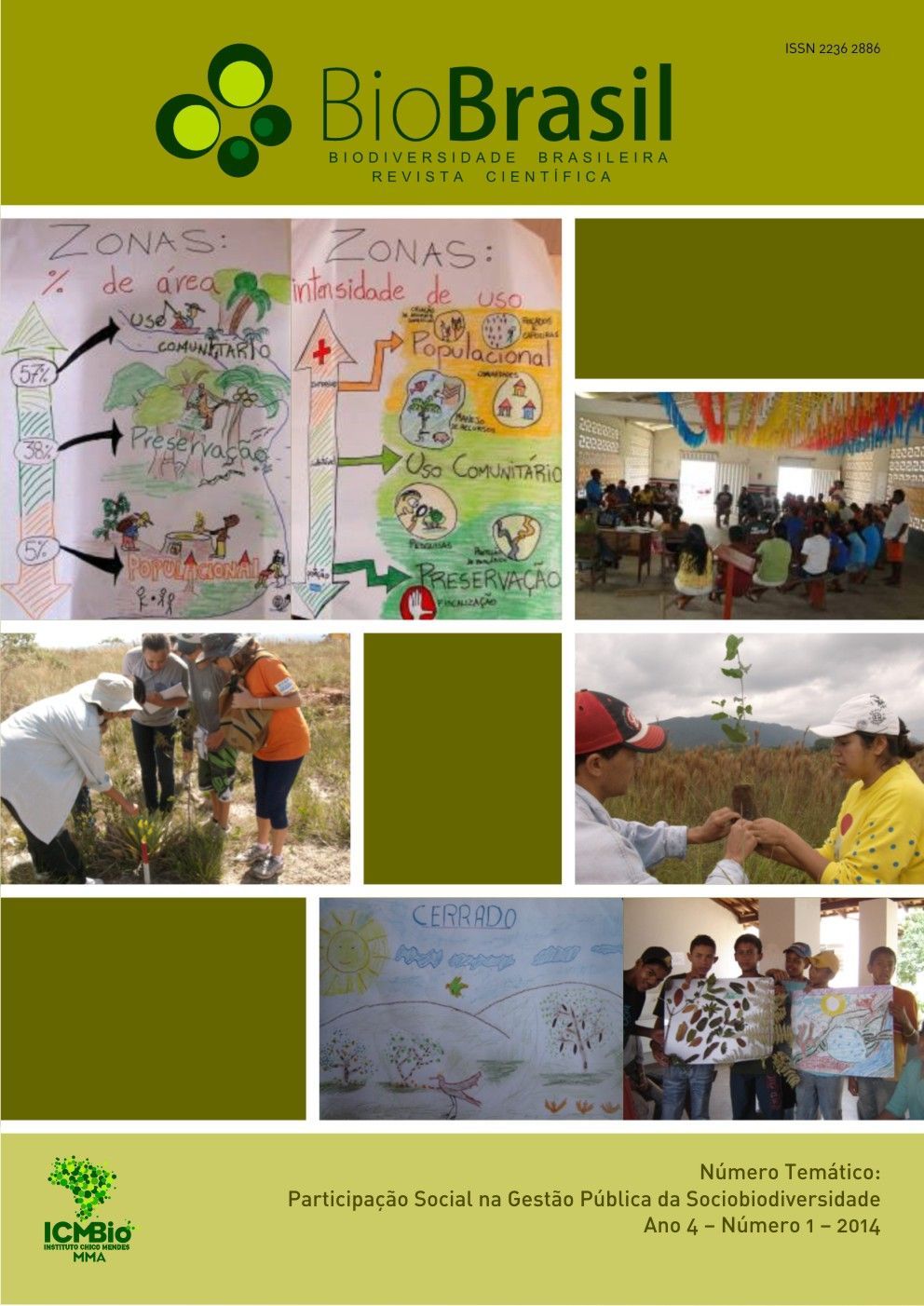Percepção dos ribeirinhos com relação ao desempenho e à gestão de duas categorias distintas de unidades de conservação na Amazônia brasileira
DOI:
https://doi.org/10.37002/biodiversidadebrasileira.v4i1.356Keywords:
Amazon, riverine community, public management, social participationAbstract
The creation of Protected Areas (UCs) can be an effective conservation strategy of several
species, including humans. However, the UCs are sometimes misinterpreted by riverine communities,
especially those of full protection, which almost always bordering complain about the ban on entry in these
areas for use of resources. Therefore, it is necessary to know the human perceptions so that makes possible to
develop measures to mitigate conflicts and convey the importance of UCs and their different categories with a
view to improving life in the communities and the conservation of biodiversity. This study aimed to evaluate
the perception of the surrounding communities Uatumã Biological Reserve (Rebio) and residents in Uatumã
Sustainable Development Reserve (RDS), Amazonas, Brazil, regarding the UCs which they are involved. Four
field excursions were carried out to the study areas, two for each UC. Questionnaires were applied to the
inhabitants regarding their relations with the UCs, which resulted in 113 interviews (62 Rebio and 51 RDS).
Most of the answers revealed that the UCs do not disturb the traditional way of life (73% Rebio and 64% RDS),
even more, the inhabitants claim that the protected areas contributed to increase hunting / fishing (~ 70% in
both UCs) and recognize that UCs directly benefit the quality of life (74% Rebio and 60% RDS). However,
reports on the communication and / or relationship with the managers of these protected areas, according to
the interviewers, demonstrated that they are divided, with 53% (Rebio) and 38% (RDS) alleging an unfriendly
relationship between managers and the inhabitants of the communities. Thus, it appears that closer relations
with the UCs managers and the communities living in and around the UCs should be improved. It is suggested
greater integration in this direction in order to prevent or minimize conflicts that may threaten the conservation
of the species and the quality of life in the communities involved with the UCs.
References
Bezerra, S.A.S.; da Silva, P.M.O.; de Souza, S.S.; Couteiro, L.F.L.; Mari, M.L.G. & Santos, R.M.S. 2010. Rebio Uatumã: percepção ambiental dos moradores da Vila de Balbina, Presidente Figueiredo, AM. I Seminário Internacional de Ciências do Ambiente e Sustentabilidade na Amazônia. Em: Anais do... CD-ROM. p. 1-9.
Brasil, 2004. Sistema nacional de Unidades de Conservação da natureza – Lei nº 9.985, de 18 de julho de 2000; Decreto nº 4.340, de 22 de agosto de 2002. 5 ed. Aum. Brasília, MMA/SBF. 56p.
Da Silva, B.M.P. 2009. Análise dos problemas de gestão em unidades de conservação: o caso da APA – Ilha de Maiandeua/PA, p.55-57. In: Medeiros R.; da Silva H.P. & Irving M. de A. (Eds.) Áreas protegidas e inclusão social: tendências e perspectivas. 346p.
Dickman, A.J. 2010. Complexity of conflict: The importance of considering social factors for effectively resolving human wildlife conflict. Animal Conservation, 13: 458-466.
Dudley, N. 2008. Guidelines for applying protected area management categories. 86p.
Eletronorte/Ibama. 1996. Reserva Biológica do Uatumã. Plano de manejo fase 1. Documento de informações básicas. 68p.
Funcate-Inpe-Aneel. 2000. Mapeamento por satélite das áreas inundadas por reservatórios de hidrelétricas brasileiras. Relatório do Convênio Funcate/Inpe/Aneel. Instituto Nacional de Pesquisas Espaciais (Inpe). .
Marinelli, C.E.; Carlos, H.S.A.; Batista, R.F.; Rohe, F.; Waldez, F.; Kasecker, T.P.; Endo, W. & Godoy, R.F. 2007. O programa de monitoramento da biodiversidade e do uso dos recursos naturais em unidades de conservação estaduais do Amazonas. Relatório Técnico. 3p.
Marinelli, C.E.; Creado, E.S.J.; Leuzinger, M.; Irving, M.; Weigand Jr., R.; Mora, S.A. & Camargo, Y.R. 2011. Avaliação de impactos sociais de áreas protegidas no Brasil: caminhos e desafios. Instituto Internacional de Educação do Brasil – IEB. 69p.
Pádua, C.V. & Chiaravalloti, R.M. 2012. Biodiversidade e áreas protegidas, p.91-95. In: Áreas protegidas. Fundo Vale. 171p.
Pinto, J.R. da S. 2010. Reserva Biológica do Uatumã: relatório de resultados do diagnóstico rural participativo (DRP): Comunidades: nova Jerusalém e Ramal do Paulista Km 179 e 180 da BR – 174. Manaus, Amazonas. 2ª. Etapa. Relatório Técnico. 48p.
RDS Uatumã. 2009. Reserva de Desenvolvimento Sustentável Uatumã – Plano de Manejo. Série Técnica Planos de Gestão. SDS/CEUC (Secretaria de Estado do Meio Ambiente e Desenvolvimento Sustentável). Vol. 1 e 2, 394p.
Van-Schaik, C. & Rijksen, H.D. 2002. Projetos integrados de conservação e desenvolvimento: problemas e potenciais. In: Terborgh, J.; Van-Schaik, C.; Davenport, L.; Rao, M. (Org.). Tornando os parques eficientes: Estratégias para a conservação da natureza nos trópicos. Ed. UFPR/Fundação Grupo Boticário de Proteção à Natureza. p. 37-51.
Zar, J.H. 1999. Biostatiscal analysis. Prentice-Hall Inc. 663p.
Downloads
Published
Issue
Section
License
Copyright (c) 2021 Biodiversidade Brasileira - BioBrasil

This work is licensed under a Creative Commons Attribution-NonCommercial-NoDerivatives 4.0 International License.
Os artigos estão licenciados sob uma licença Creative Commons Atribuição-NãoComercial-SemDerivações 4.0 Internacional (CC BY-NC-ND 4.0). O acesso é livre e gratuito para download e leitura, ou seja, é permitido copiar e redistribuir o material em qualquer mídia ou formato.





 v3-3-0-3-2-1-8-release.27
v3-3-0-3-2-1-8-release.27